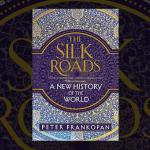The Silk Roads: A New History of the World
Peter Frankopan's The Silk Roads provides a new economic perspective on world history, taking as its centre not Europe, but the 'true middle of the world', 'the halfway point between east and west, running broadly from the eastern shores of the Mediterranean and the Black Sea to the Himalayas'. In so doing, it provides 'a major reassessment of world history', by firmly taking the action away from the West and placing it, as Frankopan would argue, back in its proper place: the crossroads of civilisations. Only by understanding this cosmopolitan and dynamic area, Frankopan argues, can we understand the history of either East or West: the flows of information, culture and economics that blended together and cross-fertilised to form the world as we know it today. As such, he covers the last 2,500 years of the history of the area, from Alexander the Great to the fallout of 9/11, showing how the events that shaped that area had an impact on the world.
Many people, even those familiar with history, have little more than a basic grasp of this area of the world, or of its impact on history. Still fewer know of the ways information and culture from the two ends of the Earth affected each other. How many people are aware that the Greek god Apollo inspired Buddhist statues and art, or that the distinctive conical headdresses worn by medieval ladies (known as hennins) were directly inspired by the Mongol court? The Silk Roads weaves these facts, and many more like them, into the grand narrativeA story; in the writing of history it usually describes an approach that favours story over analysis.A story; in the writing of history it usually describes an approach that favours story over analysis. , giving pace and interest throughout, lightening what could otherwise at times be quite a weighty tome. In shifting his historical focus away from crowded Western histories, the book also sheds new light on the West's dealings with the Middle East, particularly useful in achieving a better understanding of the current situation there. There is a reason this book has become essential reading for statesmen and diplomats.
While the West, including the Americas, gets significant mention, Frankopan takes pains to remind the reader that for much of recorded history, it has been on the periphery. After all, many of the main world-changing inventions arose in areas east of Europe. Some would argue that in taking this approach, he is missing significant leaps forward in areas other than the Middle East: the Enlightenment being one, and the rise of Ancient Rome and Greece being another. They are in there, just in a more holistic way: cause and effect are not linear, but spread out like a net along the Silk Roads. What's more disappointing is the bias towards modern history: out of 521 pages (excluding notes and similar), barely 200 pages are given to the thousands of years of history prior to the early modern period. When concentrating on the area of the world where many of those things with the biggest impact on human society were born – monotheisticBelieving only in one god, such as in Christian and Muslim beliefs.Believing only in one god, such as in Christian and Muslim beliefs. religion, farming, money – one would have hoped for more than a couple of chapters of narrative. Over a fifth of the book concentrates on the last 60 or so years, from the end of the Second World WarA global war that lasted from 1939 until 1945.A global war that lasted from 1939 until 1945. to the present. This does bring new light and understanding to an incredibly complex situation, and Frankopan makes full use of newly released - and leaked - documents to support this, but is perhaps a little too detailed compared with the rest of the book.
Despite a few errors, both factually and in analysis, Frankopan's knowledge is encyclopaedic, not just in terms of the number of unusual and interesting facts he manages to squeeze into the narrative (such as Diocletian's obsession with cabbages, and the coats of the Huns being made of the skins of field mice), but also in terms of new interpretations of events: the run-up to the First World War is not considered along the usual Arms Race lines, but seen economically, against the background of the threat of an emergent Russia, and what that could do to oil supplies. Sadly, Frankopan assumes the general reader has the same level of knowledge he has, although if this were the case, the book, with its whirlwind pace, might not be enough in-depth to satisfy the reader. For those with limited knowledge and a hazy geography of the area, at least a few more maps within the book would aid understanding.
Frankopan's fascination with history is clear throughout, as is his love of the area where East meets West. Perhaps, it could be argued, he sees it through slightly rose-tinted and optimistic spectacles: whether or not 'The Silk Roads are rising again' remains to be seen.
Peter Frankopan's The Silk Roads: A New History of the World is published in London by Bloomsbury (2015).
- Log in to post comments







